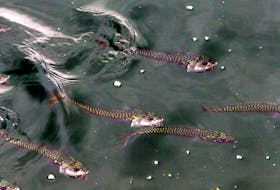A man who spent many winters and springs navigating ice around this province doesn’t believe the Titanic struck a large berg.
“I am convinced beyond everything that it was impossible,” says Capt. L. Marmaduke (Duke) Collins, a master mariner and author of the 2002 book, “The Sinking of the Titanic, An Ice Pilot’s Perspective.”
Collins, an 81-year-old St. John’s resident orignally from Carmanville, spent his working life on the water.
That included decades with the Newfoundland and Labrador harbour, coastal and ice pilotage service.
“The Titanic transited a strip of Arctic pack ice,” he says with certainty.
“Arctic pack ice is multi-year ice, a very hard ice. Numerous ships sunk the same way, by slicing open the hull. There is no credible evidence that Titanic hit or was in contact with an iceberg.”
Collins says only four crew members thought they saw an iceberg, but what they actually experienced was an illusion created by the ship’s lights shining on the ice.
Physics also dictates that the Titanic couldn’t have struck an iceberg, he says.
He explains that the Bernoulli effect means it’s not possible.
If the ship had been steaming ahead at 37 feet per second and slammed into a berg reported to be the size of a hotel, he said, the Titanic’s side would have been ripped out instantly.
“It would have sank in minutes, not hours,” he says.
“There’s the physics part of it. It could not have happened.”
Collins outlined these theories in his book, which he says sold out and was acclaimed in some countries.
But while people bought the book, it appears they didn’t all buy what was being said.
“There’s not many people who believe my theory,” he admits, “only master mariners with ice navigating experience.”
Collins’ book caught the attention of a Blink Films, a U.K.-based production company. It approached the Marine Institute in St. John’s and asked it to do a simulation.
“They were really intrigued by this,” says Capt. Chris Hearn, director of the institute’s Centre for Marine Simulation at the School of Maritime Studies.
“They were also intrigued by the fact that we could build a Titanic here, or a model of it, and they could go on and test some theories. They were also looking at the ship’s speed, how fast was she travelling and, if she had been travelling slower, would she have been able to (navigate) the ice at different accelerations.”
Hearn says the simulation was a success and the company turned it into a documentary.
“Looking at this as we did,” he continues, “made us question, actually, the size of the ice(berg).”
Hearn is now of a similar mind to Collins.
He thinks the Titanic struck a smaller piece or pieces of ice, something the crew didn’t see until the last minute.
“This great big, gigantic, lumbering piece of ice? I don’t know about that,” he says, noting that all the evidence is sitting on the ocean floor and rests with people who are no longer with us.
Collins, who isn’t a fan of the Titanic simulation, acknowledges it would take a major shift for the world to believe his theory.
Still, he hopes his opinion becomes accepted as the truth someday.
He dismisses the large berg theory as “highly unlikely.”
Twitter: @SteveBartlett_
A man who spent many winters and springs navigating ice around this province doesn’t believe the Titanic struck a large berg.
“I am convinced beyond everything that it was impossible,” says Capt. L. Marmaduke (Duke) Collins, a master mariner and author of the 2002 book, “The Sinking of the Titanic, An Ice Pilot’s Perspective.”
Collins, an 81-year-old St. John’s resident orignally from Carmanville, spent his working life on the water.
That included decades with the Newfoundland and Labrador harbour, coastal and ice pilotage service.
“The Titanic transited a strip of Arctic pack ice,” he says with certainty.
“Arctic pack ice is multi-year ice, a very hard ice. Numerous ships sunk the same way, by slicing open the hull. There is no credible evidence that Titanic hit or was in contact with an iceberg.”
Collins says only four crew members thought they saw an iceberg, but what they actually experienced was an illusion created by the ship’s lights shining on the ice.
Physics also dictates that the Titanic couldn’t have struck an iceberg, he says.
He explains that the Bernoulli effect means it’s not possible.
If the ship had been steaming ahead at 37 feet per second and slammed into a berg reported to be the size of a hotel, he said, the Titanic’s side would have been ripped out instantly.
“It would have sank in minutes, not hours,” he says.
“There’s the physics part of it. It could not have happened.”
Collins outlined these theories in his book, which he says sold out and was acclaimed in some countries.
But while people bought the book, it appears they didn’t all buy what was being said.
“There’s not many people who believe my theory,” he admits, “only master mariners with ice navigating experience.”
Collins’ book caught the attention of a Blink Films, a U.K.-based production company. It approached the Marine Institute in St. John’s and asked it to do a simulation.
“They were really intrigued by this,” says Capt. Chris Hearn, director of the institute’s Centre for Marine Simulation at the School of Maritime Studies.
“They were also intrigued by the fact that we could build a Titanic here, or a model of it, and they could go on and test some theories. They were also looking at the ship’s speed, how fast was she travelling and, if she had been travelling slower, would she have been able to (navigate) the ice at different accelerations.”
Hearn says the simulation was a success and the company turned it into a documentary.
“Looking at this as we did,” he continues, “made us question, actually, the size of the ice(berg).”
Hearn is now of a similar mind to Collins.
He thinks the Titanic struck a smaller piece or pieces of ice, something the crew didn’t see until the last minute.
“This great big, gigantic, lumbering piece of ice? I don’t know about that,” he says, noting that all the evidence is sitting on the ocean floor and rests with people who are no longer with us.
Collins, who isn’t a fan of the Titanic simulation, acknowledges it would take a major shift for the world to believe his theory.
Still, he hopes his opinion becomes accepted as the truth someday.
He dismisses the large berg theory as “highly unlikely.”
Twitter: @SteveBartlett_








